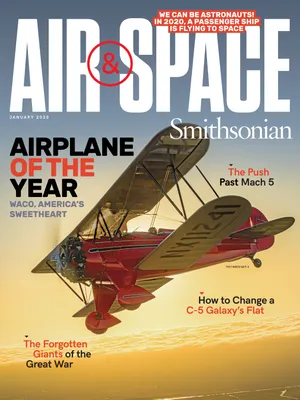Celebrating Innovation, From Kitty Hawk to Hypersonic Flight
A new gallery at the National Air and Space Museum will be dedicated to the spirit of invention.
:focal(1830x2496:1831x2497)/https://tf-cmsv2-smithsonianmag-media.s3.amazonaws.com/filer/e5/af/e5af2d29-b52a-46b9-bbf1-bfbb1ccc2f03/25a_dj2020_27a_genx14_si-2008-5559_live.jpg)
Our first flight at Kitty Hawk in 1903 came after years of hard work and centuries of dreaming. And almost as soon as we took to the skies, inventive minds began thinking up new ways to fly and new ways to incorporate aviation into our daily lives. Some of these ideas still elude us, and you’ll read about one of those challenges, commercial hypersonic flight, in this issue.
But the quest to solve seemingly intractable problems is at the core of every air and space achievement. Closer to earth, but not all the way down, is another example of an aero-puzzle that’s defied innovators and inventors for years: urban air mobility. The concept of flying cars is more than a century old, and yet always seems just over the horizon. From science fiction films to imagined cityscapes by architects like Le Corbusier and Frank Lloyd Wright, the image of urban commuters flying hither and yon has been a time-honored way to demonstrate a utopian future.
It’s a seemingly simple invention, yet the challenges of creating personal aerial vehicles that are both safe and affordable have kept us grounded for decades. But new technologies (particularly those associated with autonomous flight systems) and changing urban environments are causing innovators to revisit old ideas. With help from their drone cousins, flying cars may finally be part of a feasible future after a century of dreaming.
Iterative, collaborative invention lives across the aerospace spectrum, and will be spotlighted in new galleries at the National Air and Space Museum in the years to come. Our Innovation Gallery will explore the spirit of creativity in disruptive technology, and our Future of Spaceflight exhibit will celebrate the newest developments in Earth orbit and beyond.
We may be decades from solving the economic and environmental challenges of hypersonic passenger flight, or a host of other novel areas of aviation, but opportunities for scientific discovery, commercial development, and new leisure activities will keep these ideas on our drawing boards until they are ready to fly.
Innovation is not a straight line. It’s a herky-jerky process of setbacks and breakthroughs, sometimes over the course of decades or even generations. Ideas that defy the odds become the inventions that define our world. And as long as curious minds are drawn to these thorny problems, we’ll keep moving forward.
